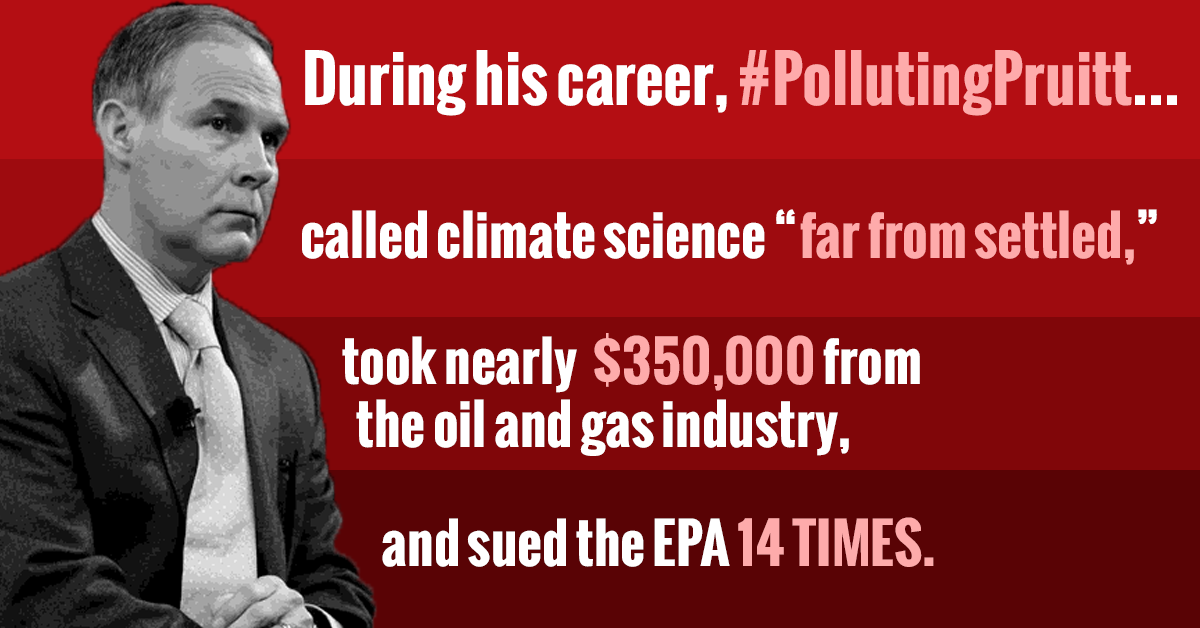Environmental activists have not hit an insurmountable obstacle with the selection of climate-change denier Scott Pruitt to lead the Environmental Protection Agency. There are other areas environmentalists can and should focus on, and reasons to not lose hope.
It’s hard to believe. A man who spent a good part of his career suing the Environmental Protection Agency is now at the federal agency’s helm. Former Oklahoma attorney general and current EPA chief Scott Pruitt is not only a longtime adversary of the environmental agency, he is also a critic of mainstream climate science.
Meanwhile, President Donald Trump has proposed a 25 percent cut to the EPA’s $8.3 billion annual budget. (Reagan, by the way, cut the EPA budget by 35 percent his first year in office.)
For environmentalists around the country, these developments are distressing. But experts closely following developments in Washington DC sound a few notes of optimism. They also advise activists to turn their attention away from the EPA at the moment and focus on other battles.
Other Focuses
Glen Brand, director of Sierra Club Maine, likes to remind Mainers they are in a strong place to push for environmental protections. “Mainers have a unique opportunity to influence two key senators — Susan Collins and Angus King,” he said.
Using this platform, Brand encourages Maine people to turn their attention right now to Trump’s nomination of Neil Gorsuch to the Supreme Court. “On the environment, Gorsuch would be terrible. He’s got a limited record, but what there is, is troubling,” Brand said.
Read more about Sierra Club’s argument against Gorsuch.

Vlad Douhovnikoff, an assistant professor of biology at Bowdoin, tells people who are upset about Pruitt that the EPA is not the only game in town when it comes to protecting — or destroying — the environment
“My take is we’re focused on Pruitt, and I am concerned that this is somewhat of a red herring,” Douhovnikoff said. “People way overestimate the influence and importance of the EPA, and actually where much of the action is is the U.S. Department of Agriculture and the Department of Interior.”
To emphasize his argument, Douhovnikoff compares the budgets and staff of the three agencies. The EPA a year or so ago (these are not current numbers) had 18,000 employees and an $8.3 billion budget. The USDA recently had 105,000 employees and its budget was $130 billion. The Department of Interior had on staff 70,000 and spent about $12 billion.
How influential are these departments on our country’s land and water? Very. The USDA manages 193 million acres of forestland and even more agricultural land. It establishes regulations on such things as soil erosion, farmland chemicals, and water standards. It is also in change of managing invasive species.
Meanwhile, 507 million acres — or one-fifth of US territory — are managed by the Department of Interior. This agency sets standards for grazing, mining, dams, wetlands, and it oversees national parks and endangered species protections.
Trump’s appointment for Interior Secretary, Ryan Zinke, began his job by overturning a ban on lead ammunition and fishing tackle in national parks and wildlife refuges. Lead ammunition used by hunters poisons and kills as many as 20 million birds and other animals each year, according to the Center for Biological Diversity.
The EPA’s primary mission is to protect human health, so it is clearly critical. Yet it can only set fines and sanctions, and, in Douhovnikoff’s eyes, is the weakest of the three federal agencies. The USDA and Department of Interior, on the other hand, have powerful tools, like agricultural subsidies, at their disposal.
So if you are worried about endangered species, invasive species, or ecosystem stability, you also need to focus on the Department of Interior or the USDA. “Don’t get distracted,” Douhovnikoff advised. “It is easy to miss the target of our concern. The EPA is important, but don’t ignore these other fights.”
Dismantling the EPA? Not so fast.
Erik Nelson, an environmental economist at Bowdoin, says that when an EPA budget is finally passed, he guesses it will only be slashed by 15 percent to 20 percent. “I suspect Sen. Susan Collins (R-Maine) will be one reason why the cuts will not be as stark as 25 percent,” he said. Of course, the EPA’s budget has been flat for the past six years, so it’s already a skeletal operation.
Nelson is also skeptical about the prospects of Trump’s proposed budget being passed in full, as it aims to trim domestic spending by $54 billion — including many programs with significant nonpartisan support — to beef up the US military and build a Mexico/US wall. Plus, he adds, “The Trump budget may not go anywhere given that it requires lifting spending caps that I am not sure enough conservatives will go along with.”
Another area of concern in the Pruitt/Trump world of environmental possibilities is the future of the U.S.’s involvement in the Paris Accord. Kate Dempsey, who heads Maine’s chapter of The Nature Conservancy, said at a recent Bowdoin College talk that the treaty, which aims to reduce greenhouse gas emissions globally, will move ahead regardless of US participation because of the value many countries see in it.
Brian Duff, a political scientist at University of New England, sees an opportunity for activism if indeed Trump pulls the US out of the climate treaty. “Why shouldn’t towns and cities, and even states, across the United States sign onto the treaty and pledge to do their part in reducing global warming emissions?” he proposed.
The flurry of activism that has sprouted in the wake of Trump’s election has energized many grassroots environmental campaigns. Lisa Pohlmann, who heads the Natural Resources Council of Maine, told students at Bowdoin College that while there will be “hard-fought losses,” during Trump’s presidency, “state and local progress will happen no matter what….There is no mandate for environmental rollbacks.”